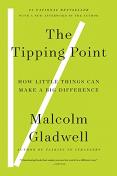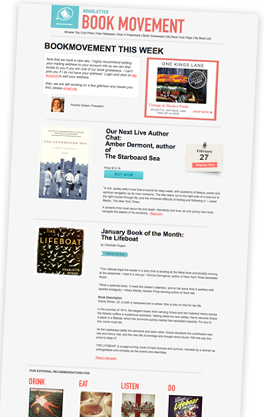BKMT READING GUIDES
The Tipping Point: How Little Things Can Make a Big Difference
by Malcolm Gladwell
Paperback : 301 pages
21 clubs reading this now
11 members have read this book
Introduction
The tipping point is that magic moment when an idea, trend, or social behavior crosses a threshold, tips, and spreads like wildfire. Just as a single sick person can start an epidemic of the flu, so too can a small but precisely targeted push cause a fashion trend, the popularity of a new product, or a drop in the crime rate. This widely acclaimed bestseller, in which Malcolm Gladwell explores and brilliantly illuminates the tipping point phenomenon, is already changing the way people throughout the world think about selling products and disseminating ideas.
Editorial Review
"The best way to understand the dramatic transformation of unknown books into bestsellers, or the rise of teenage smoking, or the phenomena of word of mouth or any number of the other mysterious changes that mark everyday life," writes Malcolm Gladwell, "is to think of them as epidemics. Ideas and products and messages and behaviors spread just like viruses do." Although anyone familiar with the theory of memetics will recognize this concept, Gladwell's The Tipping Point has quite a few interesting twists on the subject.For example, Paul Revere was able to galvanize the forces of resistance so effectively in part because he was what Gladwell calls a "Connector": he knew just about everybody, particularly the revolutionary leaders in each of the towns that he rode through. But Revere "wasn't just the man with the biggest Rolodex in colonial Boston," he was also a "Maven" who gathered extensive information about the British. He knew what was going on and he knew exactly whom to tell. The phenomenon continues to this day--think of how often you've received information in an e-mail message that had been forwarded at least half a dozen times before reaching you.
Gladwell develops these and other concepts (such as the "stickiness" of ideas or the effect of population size on information dispersal) through simple, clear explanations and entertainingly illustrative anecdotes, such as comparing the pedagogical methods of Sesame Street and Blue's Clues, or explaining why it would be even easier to play Six Degrees of Kevin Bacon with the actor Rod Steiger. Although some readers may find the transitional passages between chapters hold their hands a little too tightly, and Gladwell's closing invocation of the possibilities of social engineering sketchy, even chilling, The Tipping Point is one of the most effective books on science for a general audience in ages. It seems inevitable that "tipping point," like "future shock" or "chaos theory," will soon become one of those ideas that everybody knows--or at least knows by name. --Ron Hogan
Excerpt
ONEThe Three Rules of Epidemics
In the mid-1990s, the city of Baltimore was attacked by an epidemic of syphilis. In the space of a year, from 1995 to 1996, the number of children born with the disease increased by 500 percent. If you look at Baltimore's syphilis rates on a graph, the line runs straight for years and then, when it hits 1995, rises almost at a right angle. ...
Discussion Questions
From the Author's web site:Introduction
1. The Tipping Point is that magic moment when an idea, trend or social behavior crosses a threshold, tips, and spreads like wildfire. At what point does it become obvious that something has reached a boiling point and is about to tip?
2. The possibility of sudden change is at the center of the idea of the Tipping Point -- big changes occurring as a result of small events. If we agree that we are all, at heart, gradualists, our expectations set by the steady passage of time, is it reassuring to think that we can predict radical change by pinning their tipping points? Can we really ensure that the unexpected becomes the expected?
¨¨¨
1. The Three Rules of Epidemics
The Law of the Few
3. The 80/20 Principle states that in any situation roughly 80 percent of the “work’ will be done by 20 percent of the participants. This idea is central to the Law of the Few theory where a tiny percentage of people do
the majority of work. But say you took those 20 people who do all the “work” away, would changes or epidemics never occur or would the next 20 people step into that role and assume the position of “workers”? Is one born an exceptional person, a ‘one of the few,’ or could someone
eventually learn how to become a member of this exceptional group?
Stickiness Factor:
4. Stickiness means that a message makes an impact and doesn’t go in one ear and out the other. Take a simple, every day example of this. Think about a song that you couldn’t get out of your head or that television commercial you still remember from when you were a kid. Could you pinpoint what it is you think makes them “sticky?”
The Power of Context:
5. This says that human beings are a lot more sensitive to their environment than they may seem. How attuned are you to your environment and its effect on you? Have you felt your mood change because of the surroundings even if it’s as subtle as standing near a couple in a bitter argument or being in a cluttered, messy bedroom?
¨¨¨
2. The Law of the Few
6. Would you rather see a film, eat at a restaurant or shop at a store on hearing from a friend that it’s good or do you prefer to go in ‘blind’ with no expectations? Is the word-of-mouth phenomenon a strictly organic process or can it be manipulated? By this, I mean, do products circulate via word-of mouth solely based on their merit
and impact on the consumer or is it possible for marketers to create buzz from people paid to do so? Would this work or would this fail as soon as the ‘word’ got beyond the ‘fixed’ transmitters?
7. Connectors -- the kinds of people who know everyone and possess special gifts for bringing the world together. What kind of careers and job titles would you expect Connectors to have? Connectors are defined by having many
acquaintances, a sign of social power, but do you think a Connector privileges quantity over quality? How do Connectors embody the maxim “it’s not what you know but who you know?”
8. Maven – means one who accumulates knowledge and who has
information on a lot of different products or prices or places. Could anyone be a maven if they just have
the diligence and desire to learn a specific craft or area of knowledge?
9. Salesmen – are the select group of people with the skills to persuade us when we are unconvinced of what we are hearing. Discuss what you think makes a good salesman? Think about the last time you were in a store and
what you liked or didn’t like about the retail person assisting you? Have you ever felt suckered into buying something or recognized the only reason you bought an item (or even one in ever color) was because of the person selling it to you?
10. What happens when two people talk? They engage in a kind of dance. Their volume and pitch fall into balance and they fall into physical and conversational harmony? So, when we ‘click’ with someone, is this harmony immediately established without effort or can it be created and fine-tuned with practice or over time? Is it this synchronicity that leads to attraction? Does the way people ‘dance’ with each other indicate the presence of chemistry?
11. What would you describe yourself as -- a connecter, maven or salesman? Think of the people you know and who out of them best exemplifies these categories and why.
¨¨¨
3. The Stickiness Factor
12. Sesame Street was an example of how an agent of infection (television) was able to infect a positive virus (literacy). What are some other examples of sticky messages that aren’t as beneficial in culture?
13. What makes a message memorable? What about the commercial we dislike and we only recall because it irritated us so intensely? Haven’t the advertisers fulfilled their purpose by the sheer fact you remember their commercial? Does this mean that the cliché “even bad publicity is good publicity” is right? If something gets noticed and sticks in the viewer’s mind then does the nature of the message not matter?
14. We have become, in our society, overwhelmed by people clamoring for our attention. This information age has created a stickiness problem. Has the excessive amount of choice proved counter-productive for American consumerism? For instance, walking down the cereal aisle at the supermarket do you:
A) Buy way more than you need after spotting 3 new attractive, discounted products.
B) Head straight to your regular brand, walking out with the same cereal you have had since you were a kid.
C) Become paralyzed with indecision and leave after 2 hours with a loaf of bread?
15. What are some of the desperate measures taken by advertisers, publicists and celebrities to get noticed and stay in the limelight? How has the level of shock tactics used to grab public attention escalated and changed over time? Do we risk become totally desensitized as a culture, immune to the eyebrow-raising, attentiongrabbing ploys of marketers?
16. Do you think that children’s television shows like Sesame Street and Blues Clues are more educational and ‘stickier’ than books?
¨¨¨
4. The Power of Context (Part One)
17. Is Bernie Goetz a cold-blooded murderer or a heroic vigilante?
18. The Power of context infers that epidemics are sensitive to the conditions and circumstances of the times and places in which they occur. Are certain individuals more sensitive to their environment than others? Think of examples of behavior as a function of social context. How often or to what extent does the environment dictate your behavior i.e. your conduct when at the opera versus being at a baseball game?
19. The Broken Windows Theory argues that crime is the inevitable result of disorder. It suggests that crime is contagious. Do you agree or do you think this risks excusing a criminal’s culpability?
20. Most conservative theories say that the criminal is a personality type whereas the Broken Windows theory and Power of Context suggest the opposite – the criminal is actually someone acutely sensitive to his environment and who is prompted to commit crimes based on his perceptions of the world around him. Which theory do you believe?
21. With the subway example, the problem of fare-beating snowballed because people joined in after watching others do it. Are humans instinctively conformists who mimic the behavior they see around them?
22. The experiment led by Zimbardo, where they looked at why prisons are such nasty places, they showed that specific situations are so powerful that they overwhelm our inherent predispositions. If we improved the living conditions in prisons, do you believe it could impact on inmates’ behavior?
23. How does one explain certain exceptional figures like Gandhi and Mandela who were subject to the most brutal and atrocious conditions yet immerged seemingly uncorrupted?
24. The essence of the Power of Context is that our inner states are the result of our outer circumstances. But then, how does this work with or against the idea that our inner states ultimately create our outer world -- that perception is reality or that if we change the way we look at things, the things we look at change?
¨¨¨
5. Power of Context (Part Two)
25. The Ya-Ya Sisterhood epidemic reveals the critical role that groups play in social epidemics. Psychologists tell us much the same thing: that when people are asked to
consider evidence or make decisions in a group, they come to very different conclusions than when they are asked the same questions by themselves. Can we ever really make a decision in a vacuum, solely based on our own feelings, or do our peers or surroundings always influence us somehow?
26. The Rule of 150 suggests that the size of the group is another one of those subtle contextual factors that can make a big difference. Groups under the size of 150 are more effective as they can exploit the bonds of memory and peer pressure. Is there a particular group or organization that you consider successful and if so, what do you think makes them so effective?
27. If peer pressure is more powerful than the concept of a boss would you work harder for a boss whom you are friendly with because you care more what they think?
¨¨¨
6. Case Study: Rumors, Sneakers and the Power of Translation
28. Do you believe that it was essentially the ‘cool’ marketing campaign that tipped the Airwalk trend? Can you think of other more current products that have exploded onto the market with an equally impressive advertising assault? Would Apple computers and the iPod phenomenon, for example, be as popular if it didn’t have it’s signature marketing campaign?
29. All kinds of high-tech products fail, never making it beyond the Early Adopters, because companies fail to transform an idea that makes perfect sense to an Early Adopter to one that makes perfect sense to a member of the Early Majority. Do you know of any examples of products or ideas that looked like they had great potential but never seemed to make it to the mainstream?
30. How do weird, idiosyncratic things that really cool kids do end up in the mainstream? They are translated from a highly specialized world into a language the rest of us can understand. So, when we judge things as being weird and
idiosyncratic are we really saying that we just don’t understand it? It’s not the product but our interpretation of it that is limited? Could everything, if ‘sugarcoated’ in a way we recognize, ultimately, become palatable and even enjoyable?
¨¨¨
7. Case Study: Suicide, Smoking and the Search for the Unsticky Cigarette
31. The epidemics of suicide and smoking are complex and largely unconscious contagions with far more subtle undercurrents at work. One explanation beyond rationale is that as humans we get permission to act by seeing others engage in deviant acts. When we engage in dangerous or reckless behavior of any kind, how much of our decision
to do so is conscious versus unintentional?
32. Are you a smoker or have you ever been? What do you think makes some people pick up the habit while others steer clear of it their whole lives?
33. What are your opinions on the nature vs. nurture debate? Do you agree that environment plays a bigger role in shaping and influence children than genetics and personality?
34. “Telling teenagers about the health risks of smoking – it will make you wrinkled! It will make you impotent! It will make you dead! – is useless,” says Judith Harris. Is this morally incomprehensible advice or the sad truth? What do you think about the psychologist David Rowe’s theory that “the role of parents is a passive – providing a set of genes at loci relevant to smoking risk, but not socially influencing their offspring?” Should parents spend more time trying to monitor and shape their children’s peer group than correcting and disciplining them in the home?
35. Do you agree that instead of fighting experimentation, which is a natural and unavoidable fate of growing up, we should be rather focusing on diminishing the consequences of that experimentation? For example instead of forbidding your child from consuming alcohol when he goes out or proselytizing about the dangers of under-age drinking, should parents rather ensure there is a sober, designated driver at one of their parties? What other examples can you come up with based in this approach.
¨¨¨
8. Conclusion
36. What underlies successful epidemics, in the end, is a bedrock belief that change is possible, that people can radically transform their behavior or beliefs in the face of the right kind of impetus. Can leopards really change their spots and do you agree that it only takes the smallest infractions to cause the greatest changes? With the slightest push in the right place, can the world around us be tipped?
Weblinks
| » |
Publisher's Book Information
|
| » |
Critical Praise
|
| » |
Author Malcolm Gladwell's web site
|
| » |
Q&A from the Author's web site
|
| » |
Malcolm Gladwell's blog
|
| » |
New Yorker Article Archive
|
Book Club Recommendations
Recommended to book clubs by 4 of 6 members.
Book Club HQ to over 90,000+ book clubs and ready to welcome yours.
Get free weekly updates on top club picks, book giveaways, author events and more








